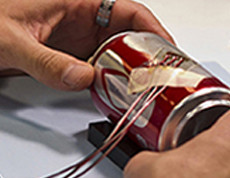What is a Strain Gage?
What is a strain gage? This page will discuss the foundation and principals that make up this highly useful sensor.
What is Mechanical Strain?
When a body (a solid object) is stressed (is subjected to a load), the body is deformed.

Strain is a measurement of the deformation, or change in shape of a solid body.
Here is an example illustrating the concept of strain: When a rubber band (solid object) is stretched (subjected to a load), the rubber band becomes longer and thinner (changed in shape). The change in length, compared to the original length, is strain.

Although it has no dimensions, strain is usually expressed in units represented as ε, which is in/in or mm/mm. Since the magnitude of the measured strain is small, the standard practice is to use units of microstrain (µε), which is [ε x 10^-6].
Stress, Strain and how are they tied together
Stress and Strains strongly tied together. In the world of Experimental Stress Analysis, we use these ties to calculate the applied stress on a body by measuring the strain and using Hooke’s Law.
Hooke’s Law states that tensile stress (σ) is linearly proportional to the strain (ε) by the modulus of elasticity (E) in the linear elastic region:

This illustrates the need to provide high accuracy strain measurement, in order to perform Experimental Stress Analysis studies to validate the strength of materials and structural designs, as well as to accurately design Load Cells, Transducers and Force sensors with Strain gages.
Stress, Strain and how are they tied together (Cont.)
This illustrates the need to provide high accuracy strain measurement, in order to perform Experimental Stress Analysis studies to validate the strength of materials and structural designs, as well as to accurately design Load Cells, Transducers and Force sensors with Strain gages.
How Does a Strain Gage Work?
The strain gage is a component used in an electrical circuit. All components in an electrical circuit exhibit some opposition to the flow of electrical current, or resistance, which can be measured by electronic instrumentation. When the strain gage is stretched (or strained), its resistance changes in direct proportion to the strain. By measuring the change in electrical resistance, the strain is also known. It’s as simple as that.

Different Strain Gages for different Stresses
Load can be applied in many different directions, with each causing a distinctive stress reaction on the body:

To meet the requirements of accurately measuring stresses & strains in such elements, specific strain gage pattern have been developed to do so:


About Linear Pattern Strain Gages | About Shear Pattern Strain Gages | About Tee Rossette Patterns
Poisson Ratio and Structural Stress Analysis:
The ratio referred to as Poisson ratio describes the ration between material deformation in perpendicular direction to the load.

Poisson's ration is usually between 0.28 and 0.33 and is opposite in sign.
How to Measure Strain when its direction is unknown?
Measuring stress where the strain has a known direction (for example: bending beam) is pretty straight forward:
A uniaxial stress condition will be calculated directly from the Strain gage reading of strain multiplied with the Modulus of elasticity

But how to measure & calculate stress while the direction of principal strains is unknown?

In order to do so, a 3-element Rosette can be used:
Using the 3-element rosette will allow to calculate he principal strains and to correctly calculated the main stress applied on the part:


Strain Gage and the Whetstone Bridge connection
Since the invention of the electrical resistance strain gage more than a half century ago, the Wheatstone bridge has become the sensing circuit of choice in most commercially available strain gage instrumentation. This is due in large measure to its inherent ability to:
1. detect the small resistance changes produced in the strain gage as it follows even minute dimensional changes on the surface of a test part under load,
2. produce a zero output voltage when the test part is at rest, and
3. provide for compensation of temperature-induced resistance changes in the strain gage circuit.
To varying degrees, each of these factors is essential for accurate strain gage measurements. In the majority of strain gage applications for the determination of the state of stress on a test-part surface, individual strain gage elements, whether from uniaxial or rosette strain gage configurations, are connected independently to the Wheatstone bridge in a quarter-bridge arrangement. As discussed
in the following sections, the wiring scheme chosen to connect the strain gage to the bridge circuit has a significant effect on the accuracy of measured strain data.
The Wheatstone Bridge

The Wheatstone bridge circuit in its simplest form (Figure 1) consists of four resistive elements, or bridge arms (R1, R2,R3, R4), connected in a series-parallel arrangement, with an excitation voltage source (E). The connection points formed by (adjacent) pairs of bridge arms and the lead wires from the excitation voltage source are input corners of the bridge; and those formed by pairs of bridge arms and the signal (eo) measurement leads are output corners. It is worth noting for this discussion that each input corner is adjacent to each output corner, and each bridge arm is connected between two adjacent corners.
Also, if the bridge circuit is resistively symmetrical about an imaginary line drawn through both output corners, the output voltage eo will be exactly zero, regardless of the excitation voltage level, and the bridge will be “balanced”.
Strain Gage Selection Guide
The initial step in preparing for any strain gage installation is the selection of the appropriate gage for the task. It might at first appear that gage selection is a simple exercise, of no great consequence to the stress analyst; but quite the opposite is true. Careful, rational selection of gage characteristics and parameters can be very important in: optimizing the gage performance for specified environmental and operating conditions, obtaining accurate and reliable strain measurements, contributing to the ease of installation, and minimizing the total cost of the gage installation. The installation and operating characteristics of a strain gage are affected by the following parameters, which are selectable in varying degrees:
• strain-sensitive alloy • backing material (carrier) • grid resistance • gage pattern • self-temperature compensation number • gage length • options
Basically, the gage selection process consists of determining the particular available combination of parameters which is most compatible with the environmental and other operating conditions, and at the same time best satisfies the installation and operating constraints. These constraints are generally expressed in the form of requirements such as:
• accuracy • test duration • stability • cyclic endurance • temperature • ease of installation • elongation • environment
The cost of the strain gage itself is not ordinarily a prime consideration in gage selection, since the significant economic measure is the total cost of the complete installation, of which the gage cost is usually but a small fraction. In many cases, the selection of a gage series or
optional feature which increases the gage cost serves to decrease the total installation cost.

Advancements in Strain Gage Technology
While there are several ways of measuring strain, the most common one is using a bonded resistance strain gage, a device whose electrical resistance varies on proportion to the amount of strain in the device.
Today, the most widely used strain gage is the Advanced Sensors Technology bonded resistance strain gage. Micro-Measurements uses a precisely manufactured (in house) metallic foil to produce to resistive element providing for the best consistency and gage to gage matching available. The metallic strain gage consist of metallic foil arranged in a grid pattern. The grid pattern maximizes the amount of metallic foil subject to strain in parallel directions.

VIDEOS
Explore our extensive collection of tutorials and informational videos on a variety of strain measurement topics.

TRAINING
Benefit from an extensive series of regularly scheduled, hands-on technical workshops and short courses.

STRAINTALKS
Explore our free education seminars aimed at helping Design and Test Engineers understand strain gage theory selection, preparation, performance, installation, configuration, and more.

STRAINBLOG
Questions and answers on the go! Listen to Micro-Measurements experts explain the many facets of strain gage technology.



